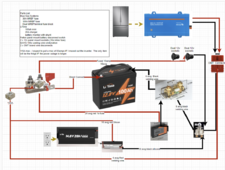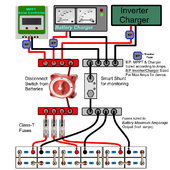Easyyokefilms
New Member
Hello, I have two different sets of batteries. Set 1 - Two 100ah Redodo 12v batteries paralleled together Set 2 - Two 100ah Litime 12v batteries paralleled together. I could not parallel all 4 together because they are from different manufacturers and I also bought them at different times. However, I have only one inverter(Renogy 12 1000w).
So here in lies my issue, the inverter comes with a 25mm cable with cable lugs at both end of the cable. However, when my battery set 1 is low, I intend to then switch the inverter from Battery set 1 to Battery Set 2. Using an Alligator clip at the end of the inverter cable seem to be the most convinient as I can easily just switch between the two batteries set but I read somewhere that alligator clips have resistance that causes power loss(I dont know if this is true). Using the cable lug that came with the inverter will be too stressful for me as I will have to continually screw and unscrew each time I need to switch the inverter from Battery Set 1 to Battery Set 2. What would be the most professional and easiest route you will take. I am still leaning towards an alligator clip, but looks like using an Anderson connector is also a good option. Which would you advice I go for that would be the easiest and safest for switching my inverter between the two sets of batteries? My load is maximum 700w so I am not using very heavy loads.
So here in lies my issue, the inverter comes with a 25mm cable with cable lugs at both end of the cable. However, when my battery set 1 is low, I intend to then switch the inverter from Battery set 1 to Battery Set 2. Using an Alligator clip at the end of the inverter cable seem to be the most convinient as I can easily just switch between the two batteries set but I read somewhere that alligator clips have resistance that causes power loss(I dont know if this is true). Using the cable lug that came with the inverter will be too stressful for me as I will have to continually screw and unscrew each time I need to switch the inverter from Battery Set 1 to Battery Set 2. What would be the most professional and easiest route you will take. I am still leaning towards an alligator clip, but looks like using an Anderson connector is also a good option. Which would you advice I go for that would be the easiest and safest for switching my inverter between the two sets of batteries? My load is maximum 700w so I am not using very heavy loads.







